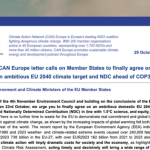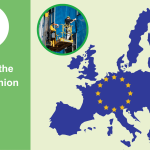National Energy and Climate Plans (NECPs) can be a powerful tool to put European countries on track to stay within the critical 1.5°C global warming threshold to avoid the worst consequences of climate change. Those plans will be revised by EU Member States by June 2024, and assessments of the draft revised NECPs have pointed out concerning findings. Against this background, and if Member States do not fix these major gaps when delivering the final version of their NECP, these plans could be challenged before courts and tribunals.
Since the entry into force of the EU Governance Regulation in 2018, legal cases focusing on NECPs have already been filed in several jurisdictions. This includes a request from an Italian NGO to the Aarhus Convention Compliance Committee, requests leading to two judgements from the Spanish Supreme Court and the case of Klimaatzaaak in Belgium. These cases either focus directly on failings relating to a certain country’s NECP (e.g. lack of public consultation during the preparation of the plan) or on a country’s overall climate ambition, using the NECP as key evidence to demonstrate related failings.
This briefing extensively analyses these cases, as they offer valuable insights for local organisations or citizens willing to start judicial proceedings on their country’s revised NECP. In particular, four lessons can be learned and applied in the future.
- Use NECPs in Court. Judges can and should be called to intervene if states do not comply with their legal obligations.
- Make your own NECP recipe. There is not only one way in which NECPs can be used in a courtroom. Each applicant, depending on the national framework, the content and the particulars of the plan, should make its own NECP recipe.
- Courts and review mechanisms may be shy to rule on public participation while consultations can still take place.
- Recycle legal arguments. There is no need to reinvent the wheel. The Aarhus Convention and EU law apply to all EU Member States. While facts are country dependent and should be carefully compiled and assessed, the legal arguments used in previous legal cases can be strategically replicated to target similar issues.
Other pending and decided cases against national governments and public authorities referring to issues related to NECPs have been filed in the Czech Republic, Estonia, Italy, Portugal and Romania (as of March 2024), although NECPs are not the main focus of the legal dispute.
NECPs covering the period 2020-2030 were first adopted in 2019 and are being updated in 2023-2024, as required by the EU Governance Regulation. The deadline for Member States to submit the draft updated plans was in June 2023. The European Commission has published an assessment of these drafts and made recommendations to Member States in December 2023 and February 2024. Each country must now take due account of these recommendations and provide the final versions of the plans by the end of June 2024.
Assessments of the draft revised NECPs undertaken by civil society, research institutes and the European Commission itself have all pointed out concerning findings. On the substance, the draft plans are collectively falling short of all EU 2030 binding climate targets and energy contributions. Individually, some Member States are backtracking on previous commitments (e.g. delaying coal phaseout) and failing to include a timeline to end national fossil fuel subsidies. The absence of a solid assessment of investment needs and financing sources has also been highlighted.
On the procedural side, there was significant delay in the submission of several draft plans, and most Member States did not organise proper public consultation processes in line with EU law or the Aarhus Convention. Several Member States also did not comply with the obligation to set up Multi Level Climate and Energy Dialogues gathering a wide range of stakeholders (local authorities, civil society, business representatives, investors and the general public) to discuss different scenarios for climate and energy policies.
Against this background, and if Member States do not fix these major gaps when delivering the final version of their NECP, these plans could be challenged before courts and tribunals. The European Commission itself announced in December 2023 that it sent a letter of formal notice to Bulgaria, Austria and Poland for failing to submit their draft revised NECP by the deadline. This is the first step of the so-called infringement procedure, which could be followed up by the Commission taking those Member States to EU court if they continue violating the law. This could ultimately result in a penalty payment imposed on those states.
Alongside judicial proceedings at the European level, local organisations and the public could also rely on national courts to force their governments to comply with their legal obligations. Climate litigation can indeed affect the outcome and ambition of overall climate governance. Potential applicants could use several legal instruments to support their claim, such as breaches of EU law, the Aarhus Convention and human rights.
Since the entry into force of the EU Governance Regulation in 2018, legal cases focusing on NECPs have emerged in several countries. These cases either focus directly on failings relating to a certain country’s NECP (e.g. lack of public consultation during the preparation of the plan) or on a country’s overall climate ambition, using the NECP as key evidence to demonstrate related failings. These cases offer valuable insights for local organisations or citizens willing to start judicial proceedings on their country’s revised NECP.
The aim of this briefing is to analyse these past legal cases in which NECPs played a key role and draw lessons that could be applied in future cases. This document identifies several practical, forward looking lessons (section II). An extensive analysis of several key legal cases focusing on NECPs is then provided (section III). These cases include:
- In Italy: the legal complaint of A Sud Ecologia e Cooperazione Odv ETS v Italy, before the Aarhus Convention Compliance Committee (ACCC)
- In Spain: the legal cases of Juicio por el Clima (I.0 and II.0), before the Spanish Supreme Court
- In Belgium: the legal case of Klimaatzaak v Belgium, before the Brussels Court of First Instance and the Brussels Court of Appeal
Another aim of this briefing is to offer a complementary approach to the Legal Intervention Guidelines on EU National Energy and Climate Plans published by the Climate Litigation Network. This document aims to provide national organisations in the EU with information about legal intervention options that could be used for challenges related to the revision of NECPs and the timeframes for legal action. The Guidelines highlight the aspects of the NECP revision process that can potentially be challenged, namely (i) public participation and consultation; (ii) the content of the NECP and (iii) its implementation. The aim of this briefing is to offer an approach complementing the Guidelines, by analysing legal cases to provide practical examples and lessons of how NECPs have been incorporated into cases so far.
NECPs in domestic litigationThe three above-mentioned cases have a strong focus on NECPs and are therefore the object of an extensive analysis in this briefing (see part III). It is also worth mentioning other pending and decided cases filed against national governments and public authorities referring to issues related to NECPs, although they are not the main focus of the legal dispute. This includes cases in the Czech Republic, Estonia, Italy, Portugal and Romania (as of March 2024). In particular, plaintiffs have relied on NECPs as a component of their evidence to support claims relating to the State’s insufficient climate mitigation efforts. For example, in Último Recurso vs Portugal (pending), the plaintiffs labelled the 2019 Portuguese NECP as “the main instrument of national energy and climate policy with a view to carbon neutrality”. The claimants flagged shortcomings identified by the Organisation for Economic Development and Cooperation (OECD) concerning the level of transparency and the adequacy of the policies identified in the 2019 NECP, which led the OECD to conclude that “it is not yet clear how Portugal will deliver on its 2030 targets”. The claimants relied on this analysis as evidence of the State’s projected failure to meet its 2030 climate mitigation objectives. Similarly, in the Italian case A Sud et al v Italy (2024), the plaintiffs described the Italian NECP as “the founding document of the response strategies of the Italian State”. The summons heavily rely on the planned policies under the 2019 NECP to demonstrate Italy’s projected failure to do its part to keep the long-term temperature limit of the Paris Agreement within reach. Moreover, some of the plaintiffs participated in the consultation phase of the preparation of the Italian 2019 NECP, submitting written observations and highlighting the NECP’s overall inconsistency with limiting global temperature rise to 1.5 °C. As such, they argued that, by ignoring the concerns and shortcomings they flagged, the State violated its duty to act in good faith in the decision-making process leading to the adoption of the NECP. This conduct further contributed to the Italian State’s alleged negligence (mainly based on the provisions of the Civil Code) in the fight against dangerous climate change. In addition, various rulings from courts in the Czech Republic, Estonia, and Romania reference NECPs in different ways, although without significant implications for the outcome of the case. In Declic et al. vs. the Romanian Government (2023, on appeal), the Court of Appeal of Cluj relied in part on the adoption of the 2019 NECP as evidence to show that the State did not show “manifest disinterest” in the achievement of its “environmental objectives” pertaining to climate mitigation. In Fridays for Future Estonia v. City of Narva-Jõesuu (2023), the Estonian Supreme Court alluded to the legal status of the 2019 Estonian NECP as a “communication” directed towards the European Commission – rather than a “strategic development document” – recalling that the 2019 NECP did not include new mitigation objectives but merely reiterated the existing domestic targets adopted in 2017. In Klimatickà žaloba (2023, on appeal), the Czech Supreme Administrative Court only referred to the Czech Republic’s obligation to submit a NECP but did not elaborate further on its legal status. |
Lessons learned from past NECPs legal cases
- USE NECPS IN COURTS
NECPs are an essential document common to all EU Member States. Adopting an NECP in line with European law and international commitments, following participatory processes, is not a choice – it is a legal duty. Judges can and should be called to intervene if states do not comply with this duty.
- MAKE YOUR OWN NECP RECIPE
In some Member States, the NECP may be the main or only document setting out national emissions reduction targets up to 2030 and the key policies that will be used to achieve these targets. In other Member States, there may be parallel national legislation containing national climate planning processes. This means that there is not only one way in which NECPs can be used in a courtroom. Each applicant, depending on the national framework, the content and the particulars of the plan, should make its own NECP recipe. Even if the NECP is not at the centre of a legal case, using it as an element of evidence can substantiate the main claims – especially in climate ambition related cases where NECPs can be a strong evidential basis to show that targets and policies are not sufficient to limit global temperature rise to 1.5C (as exemplified in Klimaatzaak).
- COURTS AND REVIEW MECHANISMS MAY BE SHY TO RULE ON PUBLIC PARTICIPATION WHILE CONSULTATIONS CAN STILL TAKE PLACE
For any legal request aiming to redress public participation failures in the preparation of (updated) NECPs, it may be preferable to wait until the end of the final process to avoid the request being deemed inadmissible. This is what happened in the case of A Sud Ecologia e Cooperazione Odv ETS v Italy before the Aarhus Convention Compliance Committee.
- RECYCLE LEGAL ARGUMENTS
There is no need to reinvent the wheel. The Aarhus Convention and EU law apply to all EU Member States. While facts are country dependent and should be carefully compiled and assessed, the legal arguments used in previous legal cases can be strategically replicated to target similar issues – for example on public participation and access to information before the Aarhus Compliance Committee, where the case of A Sud Ecologia e Cooperazione Odv ETS v Italy offers strong legal argumentation that can replicated towards other countries.
Check the full version with case studies and the complete list of references, in PDF.



